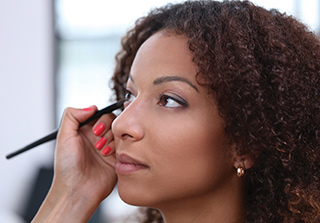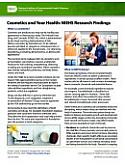Introduction

Women and men around the world use cosmetics to enhance or change their appearance. The Federal Food, Drug, and Cosmetic Act (FD&C) defines cosmetics by their intended use, as products “intended to be rubbed, poured, sprinkled, or sprayed on, introduced into, or otherwise applied to the human body...for cleansing, beautifying, promoting attractiveness, or altering the appearance."
The common term makeup refers to cosmetics such as foundation, eye shadow, mascara, and lipstick. Products for hair coloring, straightening, cleansing, or styling are considered cosmetics. Other cosmetics may include nail polish, body wash, moisturizers, and perfumes.
Under the FD&C Act, cosmetic products and ingredients, with the exception of color additives, do not require Food and Drug Administration (FDA) approval before they go on the market. However, the law requires manufacturers to report on the safety of cosmetic products to the FDA.
Drugs are regulated by the FDA and require premarket approval. Drugs are also defined, in part, by their intended use “in the diagnosis, cure, mitigation, treatment, or prevention of disease."
Some products may meet the definitions of both cosmetics and drugs. For example, foundation makeup products with sunscreen have two intended uses. The foundation helps alter the skin’s appearance, and the sunscreen component is intended to help protect skin from damage. The sunscreen component puts the makeup product in both categories.
Fact Sheets
Cosmetics and Your Health: NIEHS Research Findings
What is NIEHS Doing?
- Testing chemicals in cosmetics and personal care products – Staff in the Division of Translational Toxicology at NIEHS conduct research on chemicals used in cosmetics and personal care products, such as the following:
- Antimicrobials, such as triclosan, are used in some body washes and other products to kill or stop the growth of microorganisms, such as bacteria.
- Engineered nanomaterials, like zinc oxide and titanium dioxide, are commonly used in cosmetics and sunscreens to protect skin from harmful ultraviolet rays. Engineered nanomaterials are measured in nanometers. A nanometer is one millionth of a millimeter, or approximately 100,000 times smaller than the diameter of a human hair.
- Parabens are used to preserve the shelf life of many cosmetic and personal care products.
- Phthalates are found in cosmetics, such as nail polish and hair spray, and plastic packaging.
Sun protection cosmetics include sunscreen lotions, creams, and sprays that help prevent sunburn and resulting skin damage. Specific chemicals in these products, known as ultraviolet (UV) filters, absorb or block UV radiation from the sun. These chemicals may be added to some makeup products.
Toxicologists at NIEHS are assessing the safety of UV filters. While these studies are ongoing, findings to date do not suggest endocrine-disrupting effects from those chemicals.
- The NIEHS Sister Study – In an analysis of hair products usage, researchers found that frequent use of permanent hair dyes was associated with an increased risk of developing cancer, especially among black women. Frequent use of chemical hair straighteners was also associated with increased breast cancer risk regardless of race.1
To be clear, NIEHS research does not show that certain hair products cause cancer. Many factors affect whether cancer develops or not.
Women who used chemical hair-straightening products were at higher risk for uterine cancer compared to women who did not report using these products, according to research from The Sister Study that included more than 33,000 women. The researchers found that women who reported frequent use of hair-straightening products, defined as more than four times in the previous year, were more than twice as likely to go on to develop uterine cancer compared to those who did not use the products. Uterine cancer is relatively rare and accounts for about 3% of all new cancer cases. But it is the most common cancer of the female reproductive system.
In a separate study, researchers analyzed data on the use of genital powder and ovarian cancer from the Sister Study and three other prospective cohort studies. There was no statistically significant association between genital powder use and ovarian cancer, but they found a small increased risk of ovarian cancer for women with intact reproductive tracts (no hysterectomy or tubal ligation).2 - Salon workers and pregnancy – NIEHS-funded research found women working as cosmetologists and manicurists had an increased risk for gestational diabetes, or diabetes that develops during pregnancy. They also found a higher risk for placenta previa, a condition where the placenta partially or totally covers the cervix — the opening to the uterus — which can cause severe bleeding during pregnancy and delivery.3
- Adolescents and endocrine disruptors – NIEHS-supported research found that Latina adolescent girls, who reported daily use of personal care products, had higher levels of endocrine-disrupting chemicals in their urine, which may impact reproductive development.4
-
Eberle C, Sandler DP, Taylor KW, White AJ. Hair dye and chemical straightener use and breast cancer risk in a large population of black and white women. In press, Int J Cancer 2019; DOI 10.1002/ijc.32738. E-pub 4 Dec 2019 [Abstract Eberle C, Sandler DP, Taylor KW, White AJ. Hair dye and chemical straightener use and breast cancer risk in a large population of black and white women. In press, Int J Cancer 2019; DOI 10.1002/ijc.32738. E-pub 4 Dec 2019]
-
OâBrien KM, Tworoger SS, Harris HR, Anderson GL, Weinberg CR, Trabert B, Kaunitz AM, DâAloisio AA, Sandler DP*, Wentzensen N* (*joint senior authors). Association of genital powder use with risk of ovarian cancer. J Amer Med Assoc 2020; 323: 49. E-pub 7 Jan 2020. [Abstract OâBrien KM, Tworoger SS, Harris HR, Anderson GL, Weinberg CR, Trabert B, Kaunitz AM, DâAloisio AA, Sandler DP*, Wentzensen N* (*joint senior authors). Association of genital powder use with risk of ovarian cancer. J Amer Med Assoc 2020; 323: 49. E-pub 7 Jan 2020.]
-
Quach T, Von Behren J, Goldberg D, Layefsky M, and Reynolds P. 2015. Adverse birth outcomes and maternal complications in licensed cosmetologists and manicurists in California. Int Arch Occup Environ Health 88(7):823-833. [Abstract Quach T, Von Behren J, Goldberg D, Layefsky M, and Reynolds P. 2015. Adverse birth outcomes and maternal complications in licensed cosmetologists and manicurists in California. Int Arch Occup Environ Health 88(7):823-833.]
-
Berger KP, Kogut KR, Bradman A, She J, Gavin Q, Zahedi R, Parra KL, Harley KG. 2018. Personal care product use as a predictor of urinary concentrations of certain phthalates, parabens, and phenols in the HERMOSA study. J Expo Sci Environ Epidemiol; doi.org/10.1038/s41370-017-0003-z [online 09 January 2018]. [Abstract Berger KP, Kogut KR, Bradman A, She J, Gavin Q, Zahedi R, Parra KL, Harley KG. 2018. Personal care product use as a predictor of urinary concentrations of certain phthalates, parabens, and phenols in the HERMOSA study. J Expo Sci Environ Epidemiol; doi.org/10.1038/s41370-017-0003-z [online 09 January 2018].]
Further Reading
Stories from the Environmental Factor (NIEHS Newsletter)
- Links Between Personal Care Products and Early Puberty Mapped by New Tool (January 2024)
- Reducing Phthalates in Beauty Products May Lower Health Risks, Disparities (May 2023)
- Triclosan Worsens Fatty Liver Disease in Mice (January 2021)
Press Releases
- Sister Study Turns 20 (October 23, 2023)
- Hair Straightening Chemicals Associated With Higher Uterine Cancer Risk (October 17, 2022)
- Permanent Hair Dye and Straighteners May Increase Breast Cancer Risk (December 2019)
Additional Resources
- Cosmetics Safety Q&A – Information from the FDA
- Cosmetics and Cancer – Information from the American Cancer Society



